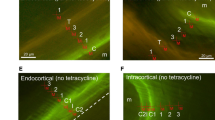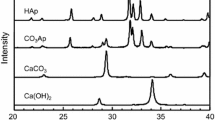Summary
Heparin in combination with suboptimal concentrations of parathyroid hormone (PTH) has been shown to stimulate calcium release from bone organ cultures. The mechanism of action of heparin, however, is not known. One possible mechanism relates to the highly sulfated structure of heparin. We have compared heparin to other glycosaminoglycans to stimulate calcium release from mouse calvarial organ cultures in the presence and absence of suboptimal concentrations of parathyroid hormone. The exogenous addition of heparin to bone cultures demonstrated only slight effects on calcium release at 5.0, 10, and 100 μg/ml. The addition of hyaluronic acid to the calvarial cultures caused a significant release of calcium at 10 and 100 μg/ml compared to 5 μg/ml hyaluronic acid. Dermatan sulfate was equally as effective as hyaluronic acid at 100 μg/ml but not at 10 μg/ml. A comparison of heparin- and hyaluronic acid-stimulated release demonstrated a significantly greater amount of calcium release with hyaluronic acid 100 μg/ml. At 5.0 and 10 μg/ml, there was no difference between heparin and hyaluronic acid in the amount of calcium released into the culture medium. When heparin was added to the organ cultures with suboptimal concentrations of PTH, there was a significant enhancement of calcium release observed with 10 and 100 μg/ml heparin compared to heparin addition alone. When hyaluronic acid was added with suboptimal concentrations of PTH, no significant enhancement of calcium release was observed with 100 μg/ml hyaluronic acid. Dermatan sulfate, chondroitin sulfates A and C, and keratan sulfate, in combination with PTH, stimulated significant calcium release compared to the glycosaminoglycan added alone. These results indicate that heparin is not a specific glycosaminoglycan stimulator of calcium release from mouse organ culture and that other glycosaminoglycans are more effective both alone and in combination with PTH.
Similar content being viewed by others
References
Martin T, Partridge N (1980) Prostaglandins, cancer and bone: pharmacological considerations. Metab Bone Dis Rel Res 2:167–171
Martin T (1983) Drug and hormone effects on calcium release from bone. Pharmacol Ther 21(2):209–228
Ibbotson K, D'Souza S, Kanis J, Douglas D, Russell R (1980) Physiological and pharmacological regulation of bone resorption. Metab Bone Dis Rel Res 2:177–189
Goldhaber P (1965) Heparin enhancement of factors stimulating bone resorption in tissue culture. Science 147(3656): 407–408
Avioli LV (1970) Heparin-induced osteopenia: an appraisal. Adv Exp Med Biol 52:375–387
Glowacki J (1983) The effects of heparin and protamine on resorption of bone particles. Life Sciences 33(11):1019–1024
Potts M, Doppelt S, Taylor S, Folkman J, Neer R, Potts J Jr (1984) Protamine: a powerful in vivo inhibitor of bone resorption. Calcif Tissue Int 36:189–193
Sakamoto S, Goldhaber P, Glimcher M (1973) Mouse bone collagenase: the effect of heparin on the amount of enzyme released in tissue culture and on the activity of the enzyme. Calcif Tissue Res 12:247–258
Lenaers-Claeys G, Vaes G (1979) Collagenase, procollagenase and bone resorption effects of heparin, parathyroid hormone and calcitonin. Biochim Biophys Acta 584:375–388
Luben R, Goggins J, Raisz L (1974) Stimulation by parathyroid hormone of bone hyaluronate synthesis in organ culture. Endocrinology 94:737–745
Luben RA, Wong GL, Cohn DV (1976) Biochemical characterization with parathormone and calcitonin on isolated bone cells: provisional identification of osteoclasts and osteoblasts. Endocrinology 99:526–534
Bartold P, Page R (1985) Isolation, identification, and quantitation of glycosaminoglycans synthesized by human gingival fibroblasts in vitro. J periodont Res 20:284–292
Larjava H, Mielityinen H, Tenovuo J, Jalkanen M, Paunio K (1982) The effect of human dental plaque on bone resorption and hyaluronic acid synthesis in in vitro cultures of fetal rat calvaria. Arch Oral Biol 27:147–150
Larjava H (1983) Effect of human dental bacterial plaque extract on the connective tissue of in vitro cultured fetal rat calvaria. Arch Oral Biol 28:371–374
Larjava H, Jalkanen M (1984) Cell surface glycoconjugates of gingival fibroblasts exposed to dental plaque extract. J Periodont Res 19:469–482
Larjava H (1984) Metabolic change in cultured gingival fibroblasts exposed to bacterial extracts, J Periodont Res 19:230–237
Larjava H, Jalkanen M, Penttinen R, Paunio K, (1983) Enhanced synthesis of hyaluronic acid by human gingival fibroblasts exposed to human dental bacterial extract. J Periodont Res 18:31–39
Merrilees M, Sodek J, Aubin J (1983) Effect of cells of epithelial rests of Malassez and endothelial cells on synthesis of glycosaminoglycans by periodontal ligament fibroblasts in vitro Dev Biol 97:146–153
Last K, Stanbury J, Embery G (1985) Glycosaminoglycans in human gingival crevicular fluid as indicators of active periodontal disease. Arch Oral Biol 30(3):275–281
Hoover RL, Rosenberg RD, Haering W, Karnovsky MJ (1980) Inhibition of rat arterial smooth muscle cell proliferation by heparin. II. In vitro studies. Circ Res 47:578–583
Castellot JJ, Cochran DL, Karnovsky MJ (1985) Effect of heparin on vascular smooth muscle. I. Cell metabolism. J Cell Physiol 124:21–28
Castellot JJ, Favreau LV, Karnovsky MJ, Rosenberg RD (1982) Inhibition of smooth muscle cell growth by endothelial cell-derived heparin: possible role of a platelet endoglycosidase. J Biol Chem 257:11256–11260
Cochran DL, Castellot JJ, Karnovsky MJ (1985) Effect of heparin on vascular smooth muscle cells. II. Specific protein synthesis. J Cell Physiol 124:29–36
Cochran DL, Castellot JJ, Karnovsky MJ (1983) Effects of heparin on vascular smooth muscle cell metabolism. J Cell Biol 97:395a
Majack R, Bornstein P (1984) Heparin and related glycosaminoglycans modulate the secretory phenotype of vascular smooth muscle cells. J Cell Biol 99:1688–1695
Lippman M, Mathews MB (1977) Heparins: varying effects on cell proliferation in vitro and lack of correlation with anticoagulant activity. Fed Proc 36:55–59
Paunio K, Multanen V-M, Larjava H, Mielityinen H, Tenovuo J (1981) The metabolism of collagen in bone culture affected by bacteria and parathormone. J Dent Res 60 (Special Issue) Abstract 558
Toole B (1981) Glycosaminoglycans in morphogenesis. In: Hay ED (ed) Cell biology of extracellular matrix. Plenum Press, New York, pp 259–294
Author information
Authors and Affiliations
Rights and permissions
About this article
Cite this article
Cochran, D.L. Glycosaminoglycan stimulation of calcium release from mouse calvariae. Specificity for hyaluronic acid and dermatan sulfate. Calcif Tissue Int 41, 79–85 (1987). https://doi.org/10.1007/BF02555249
Received:
Revised:
Issue Date:
DOI: https://doi.org/10.1007/BF02555249




